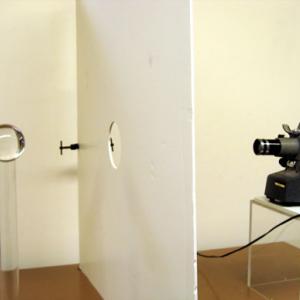College of Liberal Arts & Sciences
6A46.16 - Rainbow - Glass Beads, Spheres, and CD's
A rainbow from a drop can be simulated by filling a round flask with water. Place a large cardboard mask with a hole in the center in the middle of the table. Place the flask at the same height as the hole and on one side of the mask. Place the filmstrip projector on the other side of the mask, pointing through the hole and at the flask. Turn on the projector, and the rainbow should appear on the same side of the mask as the raindrop. A secondary bow can be seen if you look closely.
The glass crystal ball may be substituted for the flask of water. You will not see a secondary bow.
- Yuan Zheng, Kexun Shen, Xianghe Wang, Xing-Xing Yao, "Rainbows in Different Refractive Indices", TPT, Vol. 61, #5, May 2023, p. 351.
- Markus Selmke, "Ground Rainbows: A Cautionary Tale for Authors and Editors Alike", TPT, Vol. 58, #6, Sept. 2020, p. 372.
- Dave Van Domelen, "More Ideas for Projecting a Rainbow", TPT, Vol. 55, #3, Mar. 2017, p. 132.
- Dragia Trifonov Ivanov and Stefan Nikolaev Nikolov, "A New Way to Demonstrate the Rainbow", TPT, Vol. 54, #8, Nov. 2016, p. 460.
- G. Planinšič, A. Corona, and J. Slisko, "Rainbow-Like Spectra with a CD: An Active-Learning Exercise", TPT, Vol. 46, #6, Sept. 2008, p. 329.
- P. J. Ouseph, "CD Rainbows", TPT, Vol. 45, #1, Jan. 2007, p. 11.
- Paul Chagnon, "Optics for People Stuck in Traffic: License Plates", TPT, Vol. 33, #2, Feb. 1995, p. 112.
- Joseph Frick, "#168 - The Rainbow", Physical Technics: Or, Practical Instructions for Making Experiments in Physics and the Construction of Physical Apparatus with the Most Limited Means", p. 197.
Disclaimer: These demonstrations are provided only for illustrative use by persons affiliated with The University of Iowa and only under the direction of a trained instructor or physicist. The University of Iowa is not responsible for demonstrations performed by those using their own equipment or who choose to use this reference material for their own purpose. The demonstrations included here are within the public domain and can be found in materials contained in libraries, bookstores, and through electronic sources. Performing all or any portion of any of these demonstrations, with or without revisions not depicted here entails inherent risks. These risks include, without limitation, bodily injury (and possibly death), including risks to health that may be temporary or permanent and that may exacerbate a pre-existing medical condition; and property loss or damage. Anyone performing any part of these demonstrations, even with revisions, knowingly and voluntarily assumes all risks associated with them.

